When most Indians hear the iconic strains of Mozart’s Symphony No. 25, many instantly recall Titan’s signature jingle—a powerful reminder of how a brand can become deeply woven into the fabric of culture. Through its legendary ‘Joy of Gifting’ campaign, Titan transformed the simple act of giving into a deeply meaningful experience for its customers, reinforcing the emotional connection that great branding can create.
That’s the essence of effective branding—creating connections, building trust, and driving loyalty.
Yet many businesses still approach branding as a purely visual exercise, focusing on logos, taglines, and colour schemes. In reality, it starts much earlier. It begins the moment your prospect hears about your brand and decides if they should trust you as their preferred choice. And while branding has always been important, it is even more crucial in today’s social media-driven world, where consumers have higher choice and power coupled with lower attention spans. For businesses, it means customers will not wait to buy your product or experience your service to form an opinion about you. They are already assessing your intent, clarity, and consistency from your digital presence alone. This is where the power of branding truly shines—setting the stage for lasting relationships long before the first sale.
What is branding?
Branding is how your target audience perceives your business before, during, and after they interact with you. It is a set of intentional decisions you make that tells people who you are, what you’re trying to solve, and why they should trust you.
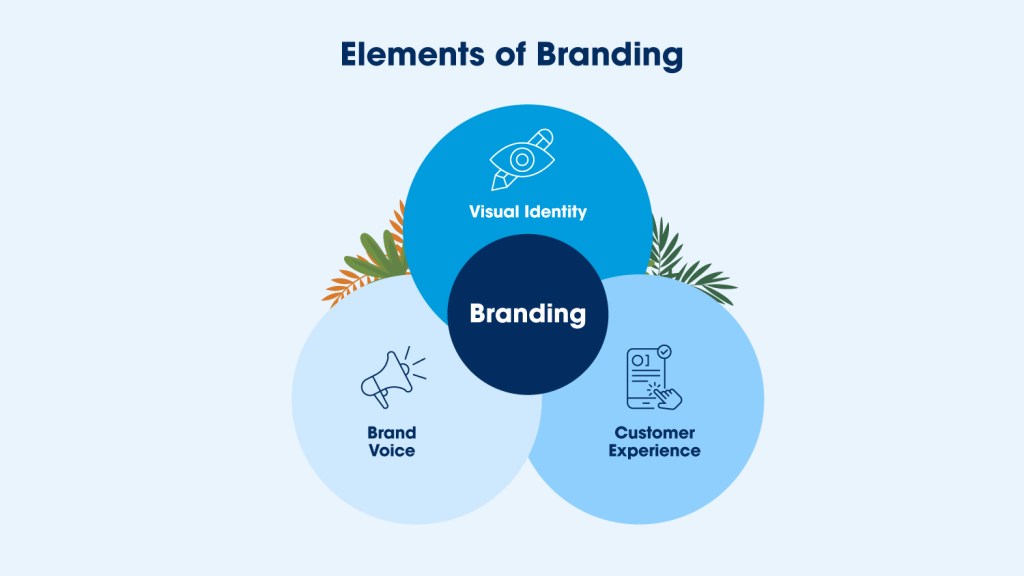
A brand is more than a logo or a catchy tagline. It includes everything from the tone of your communications, the design of your website, the style of your social media posts, to even the dress code of your employees. Anything that shapes the way the public perceives you is part of how you brand your business.
A strong brand ties together four crucial things:
- Who you are, i.e., your purpose and values
- How you sound, i.e., your tone and voice
- How you look, i.e., your logo, colour, and design
- How you behave, i.e., CX and delivery
Why branding matters more than ever
It’s a common myth that customers buy from the ‘best’ business. The reality is, they buy from businesses they trust. According to the Salesforce State of AI Connected Customer report, 61% of customers say trust is a key factor in their buying decisions.
In a mobile-first economy like India, where product parity is high and attention spans are short, decisions are driven more by perception and feeling. Add to this the huge amount of competition, and it becomes clear that businesses just can’t afford to blend in. Investing in a strong, thoughtful brand isn’t just good marketing — it’s your competitive edge.
Here’s why branding matters more now than ever:
- More people will recognise your business
One of the most obvious benefits of branding is recognition. A clear and consistent brand is far more likely to be noticed and remembered than a business with no unique identity or visual language, no matter how good the product. - Your brand builds trust long before your product ever will
Whether you’re a streetwear label or a trendy SaaS tool, buyers will want to know why you do what you do before they will even consider clicking the ‘buy’ button. Branding makes your intent visible and helps you earn trust from your audience. If a customer had to choose between a business with clear, professional-looking branding and a business that hasn’t made this effort, the choice is obvious.
Without branding, your business is just a name with features. With it, you become a story.
- Branding shortens the sales cycle
When your brand messaging is sharp and resonates with your audience, there’s less room for hesitation. Customers already know what you stand for and what to expect—so they spend less time comparing and more time buying. - Branding improves your advertising
Branding and advertising are deeply connected. You can’t advertise effectively without a strong, credible brand to showcase. When your brand is clearly defined, your ads naturally align with your identity, tone, and values. Without this foundation, your campaigns may lack cohesion and impact
When your branding is clear, your marketing becomes easier to execute—and cheaper to scale.
- Branding saves your business during slow cycles
When competitors crowd your category or when your market share dips, a brand rooted in trust and value will keep customers loyal to your business. A strong brand drives repeat traffic, customer advocacy, and stronger organic growth, acting as a business multiplier. - Branding creates loyal customers and happy employees
With good branding, you can make your brand feel more human and relatable. It can help you build stronger, emotional connections with customers, turning them into loyal buyers who will stick with you for a longer time. And it’s not just about people outside the company. Employees want to work for brands they believe in. When your team sees themselves in the brand’s purpose and values, they’re more likely to feel engaged and motivated.
Guide to mapping your customer journey
Understand which channels to use, when to contact your customer and the best type of message to use.



Branding vs marketing
Despite common assumptions, branding and marketing are not interchangeable. Branding is who you are, while marketing is how you tell people who you are. Branding shapes perception, marketing drives awareness. Branding defines your tone, marketing makes it work.
Here’s a closer look at the differences:
| Branding | Marketing |
| Builds long-term reputation and emotional connection | Drives short-term action |
| Defines identity, purpose, and values | Promotes campaigns, offers, and content |
| Works across all touchpoints | Works across specific channels |
| Owned by leadership, product, and design | Owned by marketing and sales |
| Pulls people in | Pushes the message out |
If you don’t get the branding right, even the best marketing tricks won’t stick. And if you don’t market it right, customers won’t find the brand you’ve worked so hard to build.
How to create a brand in six simple steps
A strong brand is built with intent — through clear choices, repeated consistently, across moments that matter — ensuring that your audience remembers you for the right things. Whatever your business is, your brand strategy should answer two questions clearly:
- What do you want to be known for?
- How will you consistently deliver that?
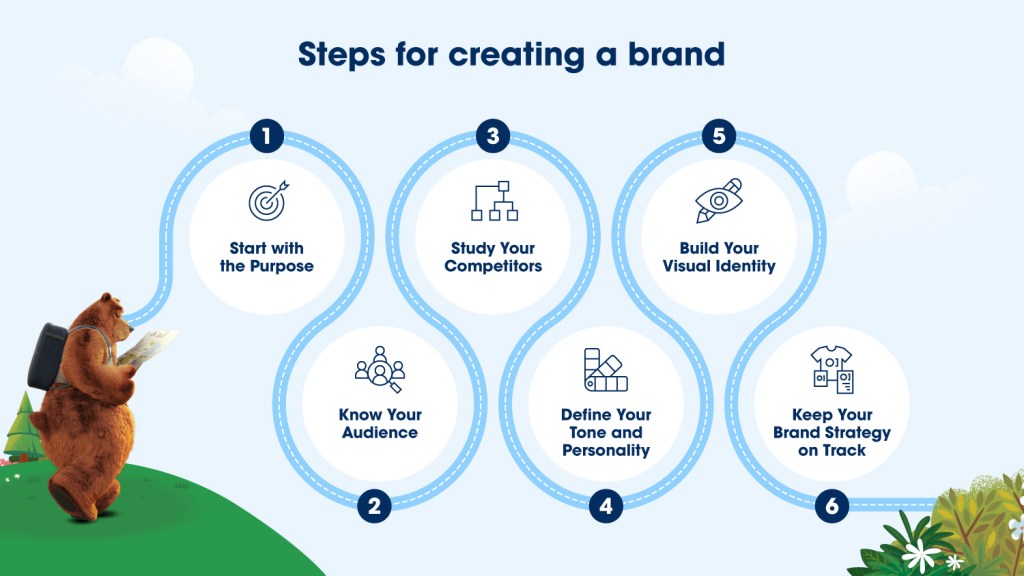
Here’s how to build a brand that scales:
1. Start with the purpose
Before you talk about your product or service, define the ‘why’ behind your business.
- Why does your company exist?
- What real-world problem can your business solve?
- Why should customers buy from you instead of going to a competitor?
This purpose, whether it’s a unique story, standout customer service, or a bold voice, can become the foundation of your brand and the reason people connect with you.
Take Nike, for example. While their tagline is the well-known “Just do it,” the company’s mission statement is far deeper: “To bring inspiration and innovation to every athlete.” This clarity of purpose shapes everything they do—from product design to brand campaigns—and ensures their messaging remains consistent and meaningful.
2. Know your audience
BIf you try to speak to everyone, you’ll be speaking to no one. Your brand should reflect the values and aspirations of your audience. For instance, if you’re targeting a younger, purpose-driven market, focus on bold, mission-led messaging or playful, unconventional design, rather than a heritage appeal.A good way to do this is by creating comprehensive buyer personas that include not just the basics (such as age, location, and income) but also more in-depth information like product use cases, motivations, and challenges.
It is far deeper: “To bring inspiration and innovation to every athlete.” This clarity of purpose shapes everything they do—from product design to brand campaigns—and
3. Study your competitors
Thorough competitor research will help you identify their strengths, capitalise on weaknesses, and find out unique niches where you can gain a strong foothold. This research includes studying their websites, social media profiles, pricing structure, and tone and voice in great detail.
4. Define your tone and personality
Tone is what makes your brand human—an entity with its own distinct voice and personality.. Are you professional or playful? Formal or conversational? And so on.
A classic example is the tone used by Zomato’s push notifications and Instagram posts. It is witty, casual, and unapologetically local. That’s brand personality in action. And your customers will notice when your tone and personality are inconsistent.
Want to learn how to build brand and marketing campaigns from scratch? Explore Trailhead to learn more.
5. Build your visual identity
Your visual identity should capture your brand’s personality and tone, shaping how customers perceive you across every touchpoint—from store shelves to digital screens. Choose colors, fonts, and logos that not only reflect your brand’s essence but also resonate with your target audience, ensuring your brand looks as modern, bold, or premium as your message.
6. Keep your brand strategy on track
Building a strong brand is just the first step. For your brand strategy to truly succeed, it needs to be actively managed across every channel, campaign, and customer touchpoint. This means monitoring your brand’s message, tracking engagement, and refining your approach as needed. Here’s how:
- Stay Vigilant: Regularly assess how your brand is perceived, listening to customer feedback, and keeping an eye on emerging opportunities.
- Build a Community: Nurture a loyal fanbase by creating content that highlights your brand’s values and adds real customer value. This could mean sharing behind-the-scenes stories, launching a podcast, or even creating interactive video content, depending on your industry.
- Track and Adapt: Measure engagement levels, monitor social conversations, and refine your brand messaging based on what resonates.
- Create Memorable Experiences: Focus on customer touchpoints, from loyalty programs to personalised digital interactions, that reinforce positive brand perceptions and long-term loyalty.
Titan’s brand evolution didn’t stop at great advertising. With a clear purpose and a deep understanding of their audience, Titan built consistent, customer-first experiences across channels. From retail to digital, their focus on trust, design, and storytelling helped them stay relevant and connected in a rapidly changing market.
Learn how Titan elevated customer engagement by building a brand that reflects joy, emotion, and real-time relevance
How to brand your business by channel
If you want your branding strategy to be effective, it has to be consistent across channels, i.e., all customer touchpoints. That means showing up with the same voice, intent, and design—everywhere your audience interacts with you.
- Website
Your website is your brand’s digital storefront. Here, your brand needs to be immediately visible, confident, clear, and easy to navigate. Don’t bury the intent three scrolls deep.
Throughout the site, use messaging that mirrors your tone, visuals that reflect your identity, and CTAs that are actionable and human.
Pro tip: Add microcopy that reinforces trust—”No spam, ever” beats “Submit.”
- Social media
It’s very likely that your audience spends most of their time on social media platforms. Pick a tone that suits your audience and stick with it.
Visual consistency matters, but so does how you comment, reply, and engage during online conversations. Whether you’re on Instagram, LinkedIn, or YouTube Shorts, every post builds (or breaks) perception.
Pro tip: Regional language posts that reflect your brand voice go a long way, especially in Tier 2 and 3 audiences.
The tone of your emails matters more than how they look or the template you use. Make subject lines feel like they’re from a person, not a brand. The voice should match what customers already associate with you—warm, helpful, playful, or direct.
Create impactful, engaging emails that land every time!



- Packaging, events, and in-store elements
For businesses existing in the physical space- whether through products, retail or experiences – maintaining brand consistency offline is equally important. Make sure your brand identity survives offline, especially if you sell through partners or distributors. Everything from QR codes to bag design to booth signage is a chance for you to showcase your brand.
- Customer service
How you respond to your customers’ queries significantly shapes brand perception. Your tone here can reinforce trust or undo all your brand-building efforts in one bad call. Scripts should match your brand voice. Apologies should feel human. Support should close the loop, not escalate it.
To truly unlock the power of your brand, consistency is key. You can deliver personalised, connected experiences across every channel, with Salesforce Marketing Cloud, reinforcing your brand message at every customer touchpoint. And, you can take this a step further with Agentforce—leveraging AI to predict customer needs, automate responses, and personalise interactions at scale. Together, these tools help you build deeper relationships, turn insights into action, and ensure your brand stands out in a crowded market.
3 examples of successful branding
The best way to learn branding is from businesses that have successfully implemented a growth strategy. Here are three examples from the real world that have redefined the rules of branding.
1. Salesforce:
Brand built on trust, community (Trailblazers), and innovation
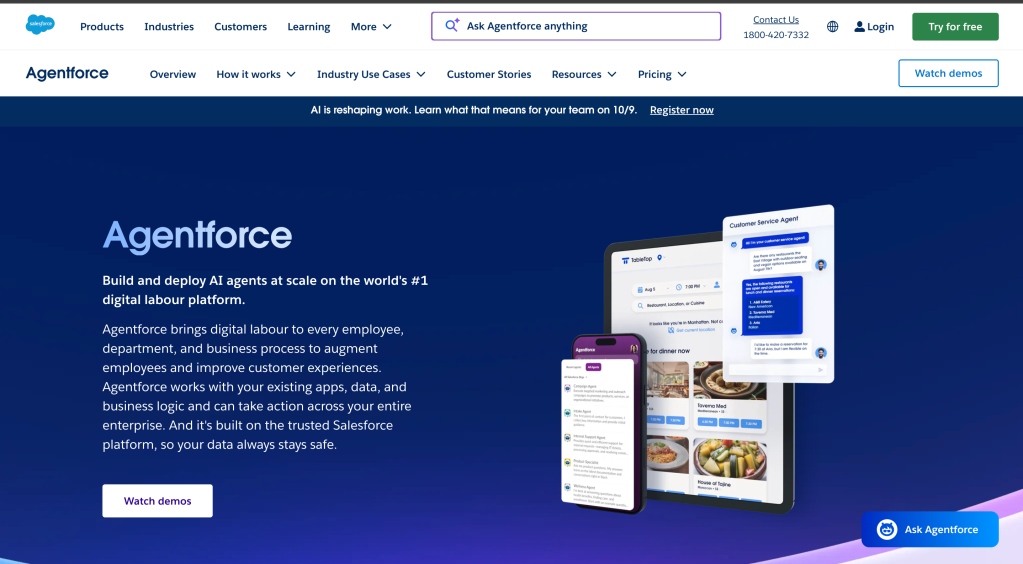
Salesforce’s brand has always been about building trust, empowering communities, and driving meaningful customer success. At one end, this is emphasised through its visual identity. Salesforce has a clean, approachable visual design with a signature blue palette and intuitive layouts. These reflect transparency, stability, and reliability.
At the other end, its solutions extend this commitment further. For instance, Agentforce allows businesses to deliver AI-driven, human-centric experiences that reinforce trust and loyalty at every touchpoint. By integrating data, automation, and real-time insights, Agentforce helps reinforce the core values of transparency, customer success, and ethical tech.
Brand takeaway: Build a brand on values customers can grow with, not just tools they can use.
2. Boat:
From headphones to lifecycle movement
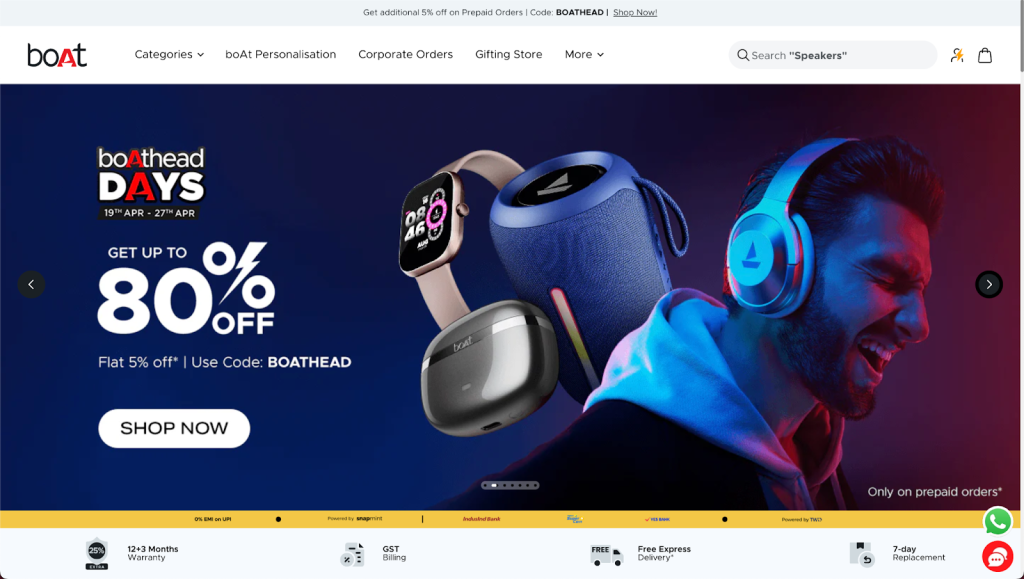
Boat entered a crowded, low-margin category and turned audio tech into youth culture. Their branding is visually bold, influencer-driven, and distinctly Indian in tone—never shy to own slang, colour, or street-level credibility.
They don’t sell “sound quality.” They sell an attitude. That’s how they made themselves more than a product—Boat products became a badge.
Brand takeaway: When you build cultural fluency into your brand, even everyday products can become identity statements.
3. Zerodha:
Branding without a noise
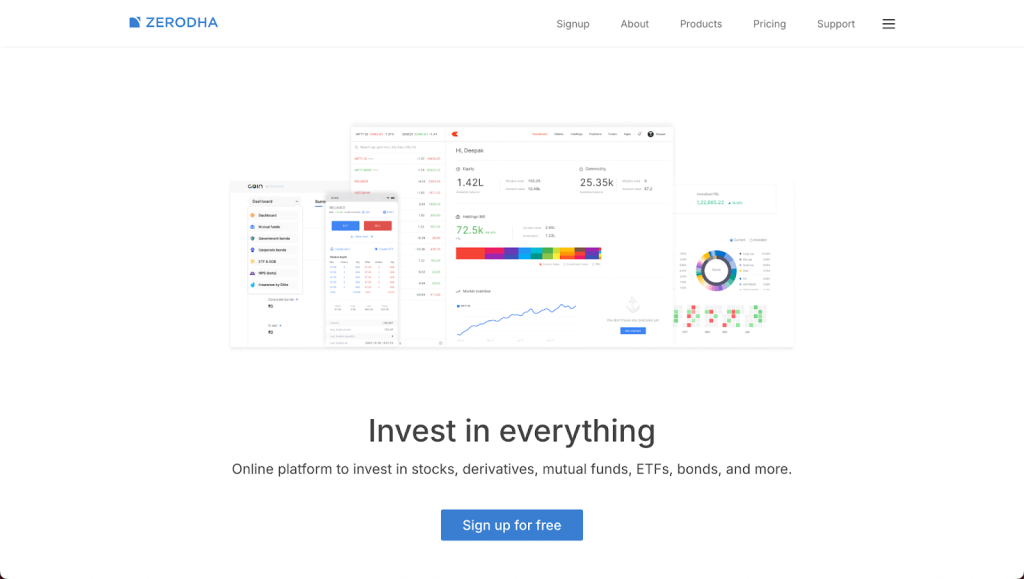
Zerodha doesn’t use flashy campaigns or celebrity faces. They have rarely done flashy ads. They built trust in a traditionally trust-deficient industry like finance by being simple, low-friction, and honest in tone. Its brand is reflected in its simple UX, education-first content, and calm, data-led communication.
Brand takeaway: In high-trust categories, your brand is only as strong as your clarity and consistency.
Branding tips for small businesses
If you know what you stand for, you do not need a big budget to build a strong brand. But what you do need is clarity in messaging, consistency in delivery, and the willingness to commit, even when it feels small.
Here’s how small businesses can begin their branding journey in small and easy steps.
- Start with one clear message
Forget the buzzwords. Pick a single truth about your business – it can be your story, your belief, or your edge. Say it consistently, everywhere. This clarity will become the first layer of your branding journey.
- Design for recall, don’t chase perfection
You don’t need a branding agency to tell you that your logo, colours, and type should feel intentional. Start simple, but make sure that everything you say reflects the way it should be said, i.e., stick to the style guide.
- Let your tone carry your personality
Ensure that your emails, captions, and WhatsApp replies sound human, helpful, and on-brand. Write like someone who understands your customer. Then write like someone they’d trust.
- Pick a channel and own it
You don’t have to be everywhere. Pick one channel where a majority of your customers are present—Instagram, a blog, a newsletter—and be great at it. Wherever you decide to show up, show up with confidence.
- Think brand before offer
Most SMEs make the fatal mistake of rushing to promotions before positioning themselves correctly. Flip the script. First, show people who you are and why you exist. Then tell them what you’re selling.
Are you looking to build a brand that customers trust and return to, again and again? Learn how to stand out with these top 5 proven branding strategies.
Every brand, big or small, carries the power to attract, retain, and grow. And when done right, branding becomes the one thing your competitors can’t copy.
At Salesforce, branding is a daily practice. It lives in the way we design our messaging, the way we serve our customers, and the way we continue innovating and building trust. Whether it’s a Trailhead lesson or a Marketing Cloud campaign, our goal stays the same: build trust at scale. To learn more about implementing effective branding strategies, explore the Brand Alignment in Distributed Organizations module on Salesforce Trailhead. It offers practical insights on delivering seamless customer engagement through distributed marketing.
Branding FAQs
Branding in marketing is the process of shaping perception. It defines how your audience sees, feels, and remembers your business, beyond just campaigns or promotions.
In business, branding refers to the strategic creation of a company’s identity through values, visuals, messaging, and customer experience. It’s how you differentiate and build long-term trust.
Personal branding is how individuals position themselves as experts or professionals. It involves building visibility, credibility, and consistency across platforms like LinkedIn, Twitter, or public speaking.
A brand promise is the commitment you make to your customers, i.e., what they can always expect from your business. It’s usually unstated, but felt across every interaction.
You build brand equity by being consistent, valuable, and trustworthy over time. It grows when customers associate your name with positive experiences and outcomes.




















